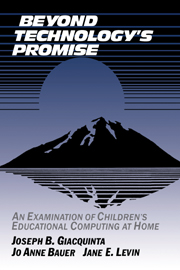Book contents
- Frontmatter
- Contents
- List of Tables and Figures
- Preface
- Chapter 1 THE PROMISE
- Chapter 2 STUDYING THE PROMISE
- Chapter 3 THE ABSENCE OF CHILDREN'S ACADEMIC COMPUTING AT HOME
- Chapter 4 THE AVAILABILITY OF EDUCATIONAL SOFTWARE
- Chapter 5 THE IMPORTANCE OF PARENTAL ENCOURAGEMENT AND ASSISTANCE
- Chapter 6 THE ROLE OF GENDER IN HOME COMPUTER USE
- Chapter 7 SCHOOL USE OF COMPUTERS
- Chapter 8 CHILDREN'S PREFERENCE FOR GAMES
- Chapter 9 REDEFINING A NEW TECHNOLOGY AS A SOCIAL INNOVATION
- Chapter 10 VIEWING TECHNOLOGICAL CHANGE AS A SOCIAL PROCESS
- Chapter 11 REEXAMINING THE HOME-SCHOOL COMPUTER CONNECTION
- Chapter 12 WHERE DO WE GO FROM HERE?
- Appendix A A FURTHER NOTE ON SITE FIELDWORK AND ANALYSIS
- Appendix B LIST OF CODES FOR SITE LOG ANALYSIS
- Appendix C SITE LOG ANALYSIS CODEBOOK
- Appendix D LIST OF FAMILIES AND SCHOOL-AGED CHILDREN
- Appendix E SPECIFIC STEPS FAMILIES MIGHT TAKE
- References
- Index
Preface
Published online by Cambridge University Press: 05 March 2012
- Frontmatter
- Contents
- List of Tables and Figures
- Preface
- Chapter 1 THE PROMISE
- Chapter 2 STUDYING THE PROMISE
- Chapter 3 THE ABSENCE OF CHILDREN'S ACADEMIC COMPUTING AT HOME
- Chapter 4 THE AVAILABILITY OF EDUCATIONAL SOFTWARE
- Chapter 5 THE IMPORTANCE OF PARENTAL ENCOURAGEMENT AND ASSISTANCE
- Chapter 6 THE ROLE OF GENDER IN HOME COMPUTER USE
- Chapter 7 SCHOOL USE OF COMPUTERS
- Chapter 8 CHILDREN'S PREFERENCE FOR GAMES
- Chapter 9 REDEFINING A NEW TECHNOLOGY AS A SOCIAL INNOVATION
- Chapter 10 VIEWING TECHNOLOGICAL CHANGE AS A SOCIAL PROCESS
- Chapter 11 REEXAMINING THE HOME-SCHOOL COMPUTER CONNECTION
- Chapter 12 WHERE DO WE GO FROM HERE?
- Appendix A A FURTHER NOTE ON SITE FIELDWORK AND ANALYSIS
- Appendix B LIST OF CODES FOR SITE LOG ANALYSIS
- Appendix C SITE LOG ANALYSIS CODEBOOK
- Appendix D LIST OF FAMILIES AND SCHOOL-AGED CHILDREN
- Appendix E SPECIFIC STEPS FAMILIES MIGHT TAKE
- References
- Index
Summary
Personal computers have become so widespread in the United States that they are now indispensable to our business world, prominent in virtually all educational settings, and present in many millions of homes. If one looks at the current literature written by the proponents of computing, the educational world looks exciting. Computers will act as catalysts, stimulating teachers to rethink the educational process. Computer integration into the curriculum will mean that children will learn with computers, as well as about them. Moreover, many educators have progressed from considering computer use as a means of helping children acquire basic skills to connecting the use of computers with exciting and invigorating ideas about how people learn and about school reform. The use of computers is also tied in with many current ideas in education – the importance of intrinsic motivation, learning by doing, cooperative learning, apprenticeship, children as designers, and parental involvement.
Just as there has been great promise for computers in school, so has there been for computers at home. Computers at home, advocates maintain, enable parents to help their children to learn in ways that never before were possible. While a great deal of research has gone into what has happened to computers at school, next to nothing has been devoted to computers at home. Our book attempts to contribute to this vital yet unstudied area. It reports the results of an analysis of qualitative information gathered on seventy families during a three-year period from early 1984 through 1986.
- Type
- Chapter
- Information
- Beyond Technology's PromiseAn Examination of Children's Educational Computing at Home, pp. xi - xivPublisher: Cambridge University PressPrint publication year: 1994

